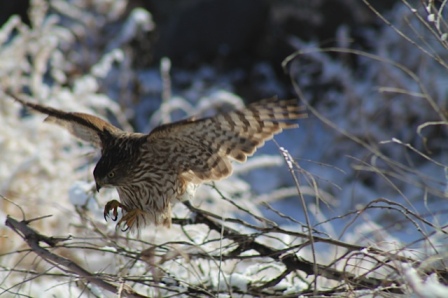
Cold seasons offer closer look at nature
Autumn and winter are perfect times for attracting birds to your yard. Autumn brings migrants that have been breeding up north during the short summer months. Each year we anticipate the great flocks of Sandhill Cranes, Snow Geese, and Canada Geese flying from Canada to winter in the Bosque del Apache, crossing a million square miles across the continent’s migratory central flyway, into New Mexico east of the Continental Divide. Among the birds that winter here are Goldeneye Northern Shoveler, Bufflehead, Blue-Wing, and Cinnamon Teal ducks, all in search of aquatic plants in our warmer ponds. Clarks and Western Grebes, and Belte Kingfishers are all seen fishing here.
Songbirds also fly the central flyway: American Robins, Eastern and Western Bluebirds, Cedar Waxwings and Townsend’s Solitaire. The peaks of the Sandia and Manzano mountains are wintering grounds for Rosie Finches migrating from Alaska. Arctic Terns are the marathon migrants, journeying from the Arctic to the Antarctic and back. Next in endurance is the Tundra Peregrine Falcon, which uses the central flyway through New Mexico. Many birds of prey leave North America on thermals in the Sangre de Cristo, following winds down the Rockies into Mexico and South America.
Among the places that I love birdwatching are the Ohkay Owingeh Lakes in the Espanola Valley. Birders have counted more than 50 species in one outing there, and identified rare species as well. In Santa Fe, the Randal Davey Audubon Center on upper Canyon Road offers educational birding tours where many species are found. Cochiti Lake provides fishing for Osprey and Bald Eagles. Las Vegas National Wildlife Refuge and Storrie Lake are also great places to enjoy the passage of many species, along with Bosque del Apache, of course.
Most of us cannot attract all of these birds to our backyards. But there are many species that will come. Black-Capped Chickadees, White-Crowned Sparrows, and Juncos bring song in winter that warm our hearts in the cold. To attract birds, you must first offer water. A heated bird bath offers rare relief when other water sources are frozen. Birds also need to bathe, as dirty down can lead to death by freezing.
In your feeders, offer light-colored seeds such as white millet, small amounts of sunflower seed, nyjer, and peanuts. Sunflower chips and shelled peanuts make wonderful winter foods, as they are easy to consume using little energy. Bluebirds are known to eat sunflower chips and suet pellets. Offering suet cakes in feeders or spreading it on the bark of trees helps attract Nuthatches, Bushtits, Titmouse, and even Warblers with fat for cold winter nights. Crunchy peanut butter can be used as well.
Bird houses can offer warmth and shelter, as can sticks stacked into piles near your feeders. These also give small birds cover from predators.
New Mexico is a great place to watch birds, whether from a home window or winter walk. The vast skies off er clear view of all that fl y and sing throughout the seasons.
Kurt Miller manages the wild bird store at Feathered Friends of Santa Fe. An aviculturist since age 13, he is training as an ornithologist through Cornell University and leads birding tours in northern New Mexico. Reach him at featheredfriends@cnsp.com.
Cooper's Hawk

Photo by Kurt Miller
